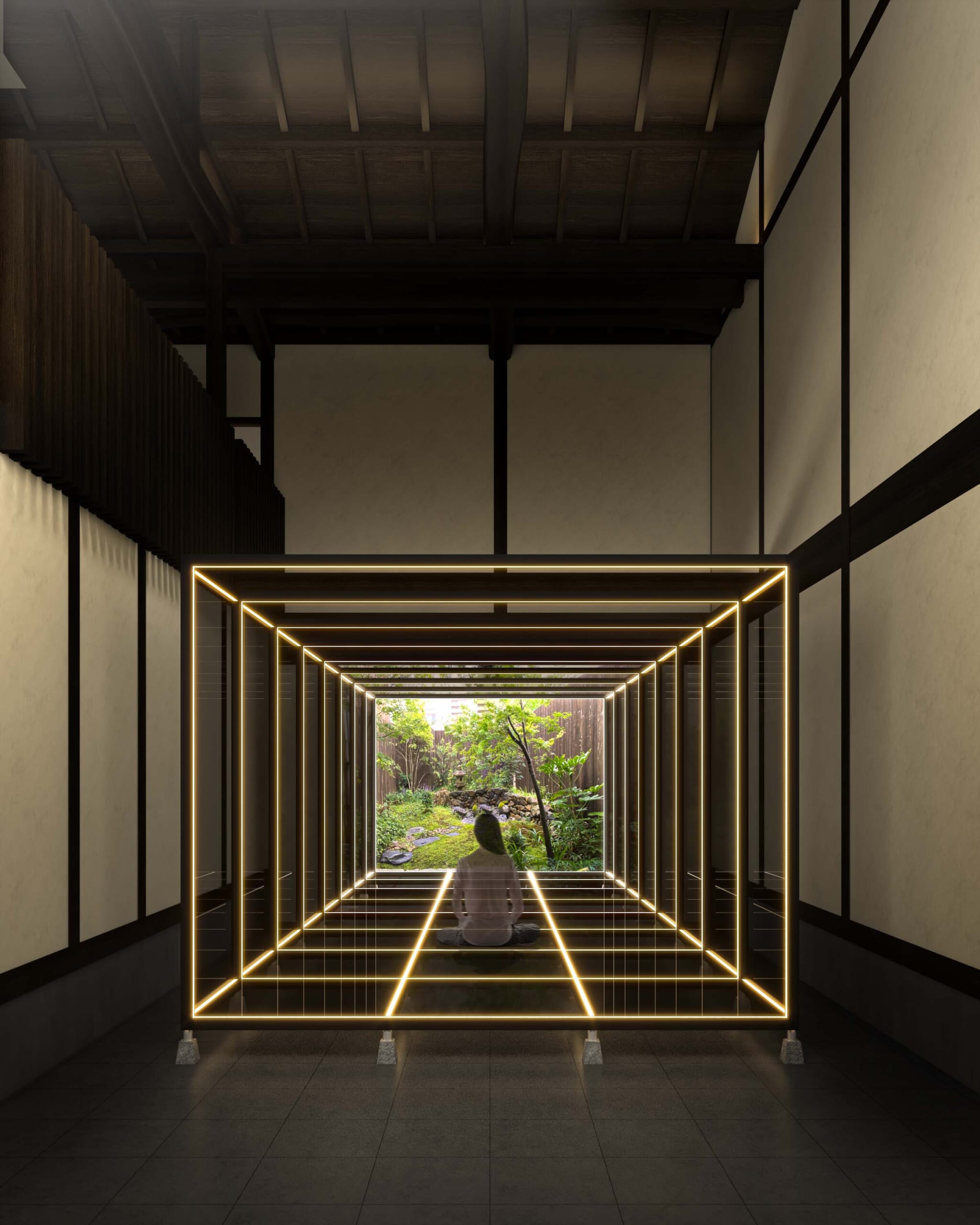
取引様態:媒介(仲介)
築100年を超える京町家
たわら庵は、明治30年(1897年)築の京町家をリノベーションした建物で、現在は宿として運営されています。
京町家は、京都の伝統的な木造家屋で、多くは商人や職人の住まいとして建てられました。京都を舞台にした映像作品には必ずといっていいほど登場するため、どこかで目にしたことがある人が多いでしょう。
表通りに面した玄関口が小さいのが特徴で、こぢんまりとした町家が狭い範囲に軒を連ねる様子は、京都を代表する風景のひとつです。のれんをくぐってみると、外観から想像するよりもずっと長い奥行きがあり、その形状から「うなぎの寝床」と呼ばれることも。大抵、奥には小さな庭があり、外から見えない場所にも手を抜かない、京人の美意識が現れています。
かつては京都中いたるところに存在した京町家ですが、戦火や開発によって数を減らし、今日も一日に2軒が消えると言われるペースで消失し続けています。
初代オーナーは、時代を代表する鋳造職人
たわら庵を建てたのは、鋳造作家・秦蔵六。秦蔵六は、江戸時代末期から代々「蔵六」の名と伝統の鋳金技法を継承している職人で、初代・秦蔵六が明治天皇の御璽と国璽を手掛けたことでも知られます。御璽は天皇の印章、国璽は国家の印章で、いずれも国家の重要な儀式や文書に用いられる、大変に格式高い道具です。それほど重要な品を任されたことからも、秦蔵六が非凡な職人であったことが分かります。
当代の六代目・秦蔵六氏によると、たわら庵を建てたのは初代または二代目であろうとのこと。以来、工房兼住まいとして、代々の秦蔵六が住み継いで来ました。長年の使用により老朽化こそしていたものの、一流職人の審美眼に叶った素材と造りは本物で、リノベーションを担当した現代の名工も目を見張りました。
目につかない場所まで、本物を使う美学
まず気が付いたのは、希少な木材を”無垢板”として贅沢に使っていたこと。現代でも、同等の木材を用いることはありますが、多くの場合、薄くスライスしてベニヤに貼り付けた“突き板”として使われます。美しい木目を有効活用するための知恵ですが、調湿性や経年変化の表情の豊かさは、やはり無垢材に叶いません。さらに驚いたのは、天井板や畳の下など、あまりに目に付かない場所にも、高いグレードの無垢材を使っていること。吉野杉や肥松といった一級品の素材を惜しみなく使われていました。
そうした素材を組み上げる技も素晴らしく、ぐねりと曲がった百日紅(さるすべり)の変木を用いた床柱や、釘を一本も用いずに組み上げた縁側の手すり、当時の大工が一本一本手作りしたと思われる隠し釘で止められた床板など、匠の技が息づいていました。
リノベーションにあたっては、こうした魅力を可能な限り活かしながら、傷んだ部分を補修するとともに、現代人の暮らしにあった設備を取り入れました。その際も、元の雰囲気と味わいを崩さないよう、最適な素材を選んでいます。
京都の歴史と文化、商業、暮らしが入り交じる立地
たわら庵は、天皇家のかつての住まいである「京都御所」のすぐ南に位置します。京都の中央と言える立地のこの場所には、さまざまな魅力があります。
まず、京都の中心に位置することから、清水寺、祇園、二条城、金閣寺、錦市場などの人気の観光スポットの多くにタクシーで15分以内でアクセスできること。また、周辺は小さな小道が碁盤の目状に走っており、ミシュラン掲載の飲食店や、老舗の菓子屋や道具店が立ち並んでいるため、近隣を歩き回るだけでも楽しめます。京都観光の拠点に最適です。
さらに、京都最大のオフィス街である烏丸御池にも徒歩10分ほどで、ビジネスユースも考えられます。京都大学をはじめとする有名大学も周辺に多く、教育環境としても申し分ありません。立地の面でも、高いポテンシャルを秘めた物件です。
More than 100-year-old Kyoto townhouse
Tawara An Retreat is a renovated Kyoto townhouse built in 1897 during the Meiji Era. It is now operated as an inn.
Kyoto townhouses are traditional wooden houses. Originally, they were built as homes for merchants and craftsmen in Kyoto. Many of you may have seen them before, as they appear in all the movies set in Kyoto, without fail.
Characterized by their small entrances facing the main street, a row of cozy townhouses is one of the most recognizable images of Kyoto. When you pass through the traditional Japanese curtain covering the entrance, you will find that those houses are much deeper than you could imagine. They are so long that, because of their shape, they are sometimes called “eel beds.” Most of them also have a small garden out back. This shows off the aesthetic sense of those from Kyoto, who are known to care about details which may not be visible when viewed from the outside.
Kyoto townhouses once existed all over the city. But wars and city development have changed this. Even today two houses disappear every day.
The first owner was a leading foundry craftsman of the time.
Tawara An Retreat was built by foundry craftsman, Zouroku Hata. Since the end of the Edo Period, the name “Zouroku”, as well as his traditional casting techniques, were passed down from generation to generation. He is even known to have handled the Imperial and State Seals of the Meiji Emperor. The fact that Zouroku Hata was entrusted with such important items shows that he was an extraordinary craftsman.
According to the current Zouroku Hata (6th generation), it was likely the 1st or 2nd generation Zouroku who built Tawara An Retreat. Since then, generations of Zouroku Hata have used the house as a workshop and residence. Although it has certainly aged over the years, the materials and construction which met the aesthetic standards of top-notch craftsmen are authentic. Even the modern master craftsman in charge of the renovation was impressed.
The aesthetics of using the authentic materials, even in places people may not be able to see
The first thing we noticed was the luxurious use of unprocessed rare wood as “solid board.” Today the same kind of wood is sometimes used, but in most cases, it is sliced thinly and pasted onto plywood to be used as “sliced veneer.” There is wisdom in using beautiful wood grain effectively. Nothing matches this solid wood in terms of the attractive appearance brought on by humidity and age. What further surprised us was the high grade of solid natural wood used in places not usually visible, like ceiling boards and under tatami mats. First-class materials such as Yoshino Cedar and Fat Pine were freely used throughout the construction.
The craftsmanship of assembling such materials was also excellent. Floor pillars made of twisted crape myrtle, railings on the porch assembled without using a single nail, and floorboards fastened using hidden nails likely hand-made one by one by carpenters at the time.
During renovations, we repaired damage while leveraging the charm of the house as much as possible. While doing this, we also introduced facilities that fit the modern lifestyle. In doing so, we chose materials that best suited the original atmosphere and flavor of the house.
A Location where Kyoto’s History, Culture, Commerce, and Lifestyle are Intermingled
Tawara An Retreat is located just south of the Kyoto Imperial Palace, the emperor’s former residence. This location, in the center of Kyoto, has many attractions.
First of all, being located in the center of Kyoto, many popular tourist spots such as Kiyomizu Temple, Gion, Nijo Castle, Kinkakuji Temple, and Nishiki Market can be reached within 15 minutes by taxi. The surrounding area is a grid of small streets, lined with Michelin-starred restaurants, long-established confectionery shops, and tool stores. This means you can even enjoy walking around the neighborhood. It is the perfect base for sightseeing in Kyoto.
Furthermore, Karasuma Oike, the largest office district in Kyoto, is only a 10-minute walk away, meaning it can even be considered for business use. Kyoto University and other famous universities are also located in the area, making it a perfect educational environment.
IDEAS
-

飲食店経営トライアル賃貸としての活用法 Proposal for use as a Trial Lease for Restaurant Management
学生コンテスト優秀作品集
-

健やかに、学ぶ、寄ル 『YAKU doko』 for Wellness, for Wisdom, for Gathering "YAKU doko"
ノンスケール
-

NARROW RESORT
HÜNE
-

FABRIC TAWARA FABRIC TAWARA
学生コンテスト優秀作品集
-

Floating in "KYOMACHIYA" Floating in "KYOMACHIYA"
学生コンテスト優秀作品集
-

京町シネマ Kyomachi-CINEMA
学生コンテスト優秀作品集
-

幾重に重なる緑と3つの庭 Layers of Greenery and The Three Gardens
学生コンテスト優秀作品集
-

町家カフェと滞在型ポップアップストア Machiya Café and a Pop-up Store with Lodging Feature
学生コンテスト優秀作品集
-

京との結婚 Marrying to Kyoto
学生コンテスト優秀作品集
-

京町家の継承と更新 Inheritance and update of Traditional Kyoto machiya
YNY
-

たわら庵アートサイトプロジェクト Tawara-An Treat Art-site Project
学生コンテスト優秀作品集
-

みんなの貸し部屋 Room for Rent for Everyone
学生コンテスト優秀作品集
-

食を通じて、文学の世界に入り込む The World of Literature through Food
学生コンテスト優秀作品集
-

きょう “京・今日” の日常 Daily Life in Kyoto as “Kyo” & Today as “Kyo”
学生コンテスト優秀作品集
-

体感する町家 Experiencing Machiya
PASSE ARCHITECT
OUTLINE
- Address:
- 京都府京都市中京区俵屋町(富小路通)
- Tags:
-
- 日本家屋 / Japanese-Style House
- Address:
- Tawaraya-cho, Nakagyo-ku, Kyoto City (Tominokoji Street), Japan
- Site area:敷地面積:
-
㎡0123456789012345678901234567890123456789
- Gross floor area:延床面積:
-
㎡0123456789012345678901234567890123456789















